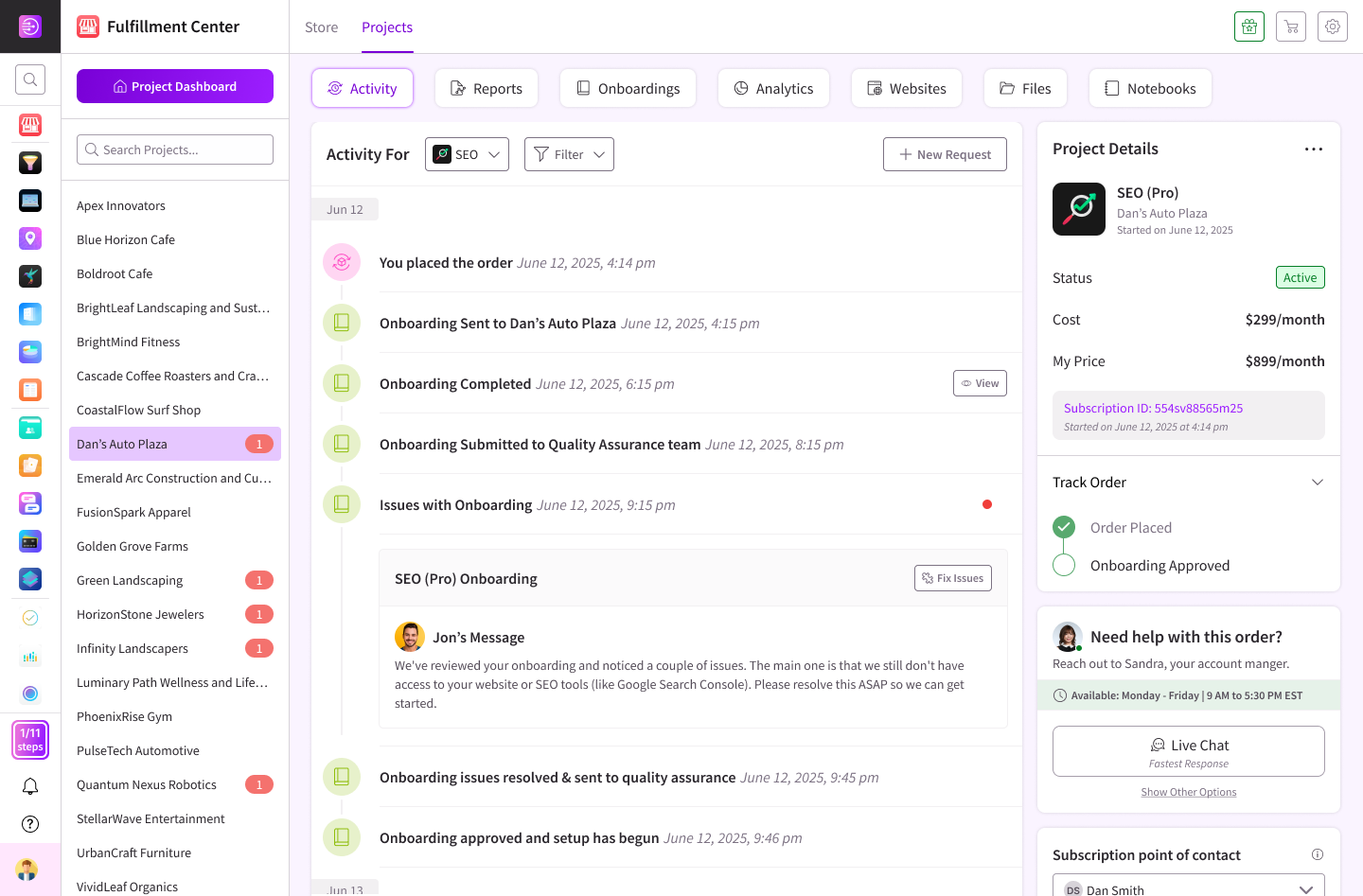SEO results can feel like a rollercoaster. One month, your client's website dominates search results, and the next, they've plummeted to page three. These inevitable dips test every agency's communication skills and client relationships. The question isn't whether rankings will fluctuate—it's how you'll handle those conversations when they do.
Agencies using white label SEO services face unique challenges during these periods. You're managing client expectations while coordinating with external teams who may have limited direct client interaction. The pressure mounts when clients demand answers about declining metrics, yet your outsourced SEO partners are still implementing long-term strategies behind the scenes.
Smart agencies have learned that surviving these conversations requires more than damage control. It demands a complete reframe of how you present SEO value, communicate progress, and maintain client confidence. This comprehensive guide reveals proven strategies for explaining SEO progress when rankings refuse to cooperate, helping you transform potential client losses into stronger partnerships.
Why SEO Rankings Drop (And How to Explain It)?
Understanding the root causes of ranking declines gives you the foundation for meaningful client conversations. Google processes over 13.7–14 billion searches daily, with algorithm updates occurring multiple times per week. Your clients' rankings exist within this constantly shifting landscape.
A. Algorithm Updates Hit Without Warning
Google's core algorithm updates can dramatically reshape search results overnight. The helpful content update in August 2022 caused widespread ranking fluctuations across industries. When working with white label SEO services, these updates affect multiple client portfolios simultaneously, creating perfect storms of client concern.

Explain to clients that algorithm updates are like rule changes in sports. Teams that were winning under the old rules need time to adapt their strategies. The SEO fundamentals remain unchanged—quality content, technical optimization, and user experience—but the emphasis on specific factors shifts.
B. Seasonal Fluctuations Mirror Business Cycles
Many industries experience predictable search volume changes. Tax preparation services see massive spikes in January through April, then dramatic drops afterward. E-commerce sites selling holiday decorations face similar patterns. These seasonal shifts affect both search volume and competition intensity.
When outsourcing SEO services, ensure your provider tracks these patterns and prepares clients for expected fluctuations. Historical data becomes your strongest ally in these conversations, showing clients that current drops align with previous years' patterns.
C. Competitor Activity Intensifies
Your clients aren't operating in a vacuum. Competitors launching aggressive SEO campaigns, publishing comprehensive content, or investing in technical improvements can impact relative rankings. When multiple competitors simultaneously improve their SEO efforts, even maintaining your position becomes challenging.
This competitive pressure particularly affects agencies using white label SEO services for agencies. Multiple SEO providers working across similar client bases can create indirect competition, where improvements for one client affect others in the same industry.
Reframe Rankings Around Business Impact
Moving conversations away from rankings toward business outcomes protects both client relationships and your agency's reputation. Rankings serve as means to an end—the end being increased revenue, leads, and brand visibility.
1. Connect SEO Metrics to Revenue Drivers
Transform ranking discussions into revenue conversations. Instead of explaining why keyword X dropped from position 3 to position 7, demonstrate how organic traffic continues generating qualified leads. Show how branded search volume increased, indicating improved brand awareness from content marketing efforts.
Create dashboards connecting SEO metrics to business outcomes. Track organic traffic to high-converting landing pages, measure lead quality from organic visitors, and monitor customer lifetime value from SEO-generated customers. These metrics paint a complete picture beyond simple ranking positions.
2. Highlight Expanded Keyword Visibility
Modern SEO success involves ranking for thousands of long-tail keywords rather than focusing solely on high-volume head terms. When primary keywords drop, your white label SEO services might be simultaneously improving visibility for dozens of related terms.
Present clients with keyword expansion reports showing new ranking positions. A drop for "digital marketing agency" might coincide with new rankings for "B2B digital marketing services," "enterprise marketing automation," and "growth marketing consultants." The net effect could be positive despite the primary keyword decline.
3. Demonstrate Market Share Growth
Rankings exist within market contexts. Your client might drop from position 2 to position 4 while the overall search volume for their industry increased 40%. Their actual share of clicks could remain stable or even grow despite the ranking decrease.
Use tools to calculate the estimated click-through rate and traffic shares. Show clients how their visibility compares to competitors over time, not just their absolute rankings. This broader perspective helps clients understand their true market position.
Communicate Long-Term SEO Value
SEO campaigns require patience, especially when working with outsourced SEO services that follow methodical, proven processes. Agencies must educate clients about SEO timelines while maintaining momentum during slower periods.
1. Establish Realistic Timeline Expectations
Google typically takes 4-6 months to fully evaluate and respond to SEO improvements. When your white label SEO services implement technical fixes or content strategies, results often lag significantly behind the work performed. This timeline disconnect creates communication challenges.

Create visual timelines showing when different SEO activities were implemented and when results typically appear. Link current ranking fluctuations to work performed 3-6 months ago, helping clients understand the delayed nature of SEO results. Similarly, show how current activities will impact future performance.
2. Showcase Foundation Building
Much SEO work involves strengthening website foundations that don't immediately impact rankings but create platforms for future growth. Technical improvements, site architecture optimization, and content hub development fall into this category.
Document these foundational improvements with before-and-after comparisons. Show page speed improvements, mobile usability enhancements, and crawl error reductions. While these don't immediately boost rankings, they prevent future problems and enable better performance as other SEO elements mature.
3. Present Compound Growth Potential
SEO improvements compound over time. A single piece of content might rank poorly initially but attract backlinks, social shares, and user engagement that gradually improve its performance. This compounding effect accelerates as your SEO foundation strengthens.
Use case studies from similar clients to illustrate compound growth patterns. Show how websites that maintained SEO investments during flat periods eventually experienced exponential growth as various optimizations reached critical mass.
Leverage Data Storytelling Techniques
Raw data overwhelms clients and obscures positive trends. Effective agencies transform data into compelling narratives that maintain client confidence during challenging periods.
1. Create Multi-Metric Dashboards
Single-metric reporting (like rankings alone) creates vulnerability when any one metric declines. Comprehensive dashboards showing rankings, traffic, conversions, and client engagement provide balanced perspectives on SEO performance.
When working with white label SEO services, ensure your reporting includes metrics beyond their direct control. Add social media engagement, direct traffic growth, and brand mention volume to show how SEO efforts contribute to broader marketing success.
2. Use Comparative Analysis
Context makes data meaningful. Compare current performance to:
- Previous year's same period (accounting for seasonality).
- Industry benchmarks and competitors.
- Pre-SEO campaign baselines.
- Different traffic sources (showing organic growth relative to other channels).
These comparisons help clients understand whether declines represent temporary setbacks or concerning trends requiring strategy adjustments.
3. Highlight Leading Indicators
While rankings and traffic are lagging indicators, other metrics predict future performance. Increased branded search volume, improved page engagement metrics, and growing social shares often precede ranking improvements.
Train clients to recognize these leading indicators during your regular reports. When rankings drop but engagement metrics improve, you can confidently predict future ranking recovery based on these positive signals.
Further Reading: Data Storytelling: Why Every Agency Needs to Adopt This Skill
Address Technical SEO Invisibly
Technical SEO improvements rarely generate immediate excitement but prevent catastrophic problems. Agencies must communicate technical work value without overwhelming clients with complexity.
1. Translate Technical Terms
Instead of reporting "improved Core Web Vitals scores," explain "faster page loading that improves user experience and search rankings." Replace "fixed crawl errors" with "removed barriers preventing Google from understanding your website content."
Your outsource SEO services team likely uses technical language in their reports. Translate these updates into business benefits clients can understand and appreciate.
2. Show Competitive Technical Advantages
Many websites have significant technical problems that limit their SEO potential. When your technical optimizations surpass competitor websites, you gain sustainable advantages. Use SEO tools to compare your site's technical performance against competitors.
Present these comparisons during ranking decline discussions. Show how your technical superiority positions the client for better long-term performance, even during temporary ranking fluctuations.
3. Connect Technical Improvements to User Experience
Google's algorithms increasingly prioritize user experience signals. Technical improvements that enhance user experience directly impact rankings over time. Frame technical SEO work as user experience investments rather than search engine manipulation.
Build Content Authority Systematically
Content marketing and SEO integration create lasting competitive advantages. When rankings decline, strong content strategies provide alternative value propositions for continued investment.
1. Document Thought Leadership Development
High-quality content establishes industry authority that transcends individual keyword rankings. Track metrics like:
- Industry publication mentions and backlinks.
- Speaking opportunity requests.
- Journalist inquiries and media coverage.
- LinkedIn engagement and follower growth.
These indicators show how SEO-driven content marketing builds brand authority beyond search rankings.
2. Measure Content Performance Holistically
Individual blog posts might not rank immediately but contribute to overall domain authority and topical expertise. Track content performance across multiple dimensions:
- Social Media Engagement and Shares.
- Email Newsletter Click-Through Rates.
- Sales Team Usage in Client Conversations.
- Lead Magnet Conversion Rates.

When white label SEO services create content that supports multiple marketing channels, the value extends far beyond search rankings.
3. Connect Content to Sales Conversations
Sales teams often reference blog content during prospect conversations. Track these interactions and their impact on deal closure rates. Content that doesn't rank well might still influence purchasing decisions when sales representatives share it directly with prospects.
Maintain Momentum During Flat Periods
Ranking plateaus test client patience and agency relationships. Smart agencies use these periods to strengthen foundations and prepare for future growth phases.
1. Implement Advanced Testing
Flat ranking periods provide opportunities for sophisticated testing without risking established positions. Test different title tag formulations, meta descriptions, internal linking strategies, and content formats to identify improvement opportunities.
When working with outsourced SEO services, ensure these testing programs continue during slow periods. Document testing results and use them to demonstrate ongoing optimization efforts.
2. Expand Keyword Targeting
Ranking declines for primary keywords might indicate opportunities to target related terms with less competition. Use keyword research to identify adjacent opportunities that align with client business goals.
Show clients how keyword expansion strategies reduce dependency on any single ranking position while building broader topical authority.
3. Strengthen Local SEO Components
Local SEO elements often improve more quickly than national organic rankings. Focus on Google Business Profile optimization, local citation building, and location-specific content creation during national ranking plateau periods.
For agencies using white label SEO services for agencies, local SEO provides excellent opportunities to show progress while longer-term national strategies develop.
Handle Client Escalations Professionally
Even the best communication strategies face client escalations during extended ranking declines. Prepare systematic responses that maintain relationships while addressing concerns directly.
1. Acknowledge Concerns Directly
Never dismiss client concerns about ranking declines, even when you understand the bigger picture. Acknowledge their frustration and validate their business concerns before explaining the broader context.
Create escalation protocols that involve both your agency team and white label SEO services providers.

Ensure everyone understands their role in client communication during difficult periods.
2. Provide Actionable Next Steps
Clients need to feel that their concerns drive concrete actions. Present specific steps your team will take to address ranking declines, including:
- Detailed competitive analysis updates.
- Technical audit scheduling.
- Content strategy adjustments.
- Timeline revisions with specific milestones.
When outsourcing SEO services, ensure your provider can support these action plans with additional resources or strategy modifications.
3. Offer Transparent Reporting Increases
During challenging periods, increase reporting frequency and transparency. Weekly check-ins replace monthly reports, and detailed work logs replace summary updates. This increased transparency demonstrates a commitment to addressing client concerns.
How DashClicks Can Help Agencies Increase Clients' Rankings?
DashClicks offers a comprehensive suite of tools and services that enable agencies to elevate their clients' search engine rankings effectively. Through its white label SEO services, DashClicks enables agencies to access expert-level strategies without the need to hire in-house specialists. Their team of seasoned professionals performs in-depth keyword research, competitor analysis, and on-page and off-page optimization to ensure websites align with the latest search engine algorithms.
Additionally, they offer advanced reporting features through their user-friendly dashboard, delivering real-time updates on key performance metrics like keyword rankings, organic traffic, and domain authority. This transparency allows agencies to keep clients informed of progress while fostering trust and confidence.
DashClicks also provides a seamless workflow by integrating with tools like InstaSites for quick website creation and offering automated processes to save time and boost efficiency. With these resources, agencies can focus on scaling their business while ensuring consistent ranking improvements for their clients.
Your Strategic Response to SEO Challenges
SEO ranking fluctuations are inevitable, but client relationships don't have to suffer. Agencies that master these communication challenges build stronger partnerships and more sustainable businesses. The key lies in shifting conversations from rankings alone toward comprehensive business impact and long-term growth potential.
White label SEO services for agencies provide tremendous opportunities to deliver results at scale, but they require sophisticated communication strategies during challenging periods. Clients need to understand the value being created behind the scenes, even when immediate rankings don't reflect that work.
The most successful agencies treat ranking declines as opportunities to strengthen client relationships through education, transparency, and strategic reframing. They use these periods to demonstrate expertise, build trust, and prepare clients for future growth phases.
Remember that SEO success spans years, not months. Agencies that help clients maintain this perspective during temporary setbacks create partnerships that survive algorithm updates, competitor activity, and market changes. Your ability to communicate SEO value during challenging periods ultimately determines both client retention and business growth.



.svg)

.svg)
.svg)
.svg)
.svg)
.svg)

.svg)




.svg)
.svg)
.svg)
.svg)
.svg)